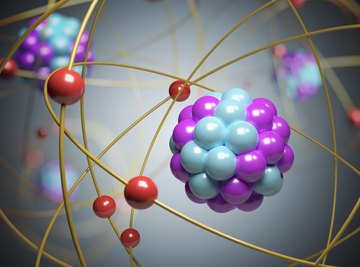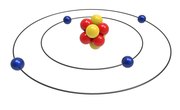
Scientists today envision atoms as being composed of tiny, heavy, positively charged nuclei surrounded by clouds of extremely lightweight, negatively charged electrons. This model dates back to the 1920s, but it has its origin in ancient Greece. The philosopher Democritus proposed the existence of atoms around 400 B.C. No one really took up the idea with any fervor until English physicist John Dalton introduced his atomic theory in the early 1800s. Dalton's model was incomplete, but it persisted basically unchanged throughout most of the 19th century.
A flurry of research into the atomic model occurred at the end of the 19th and well into the 20th century, culminating in the Schrodinger model of the atom, which is known as the cloud model. Soon after physicist Erwin Schrodinger introduced it in 1926, James Chadwick – another English physicist – added a crucial piece to the picture. Chadwick is responsible for discovering the existence of the neutron, the neutral particle that shares the nucleus with the positively charged proton.
Chadwick's discovery forced a revision of the cloud model, and scientists sometimes refer to the revised version as the James Chadwick atomic model. The discovery earned Chadwick the 1935 Nobel Prize in physics, and it made possible the development of the atomic bomb. Chadwick participated in the super-secret Manhattan project, which culminated in the deployment of nuclear bombs on Hiroshima and Nagasaki. The bomb contributed to the surrender of Japan (many historians believe Japan would have surrendered anyway) and the end of World War II. Chadwick died in 1974.
How Did Chadwick Discover the Neutron?
J.J. Thompson discovered the electron using cathode ray tubes in the 1890s, and British physicist Ernest Rutherford, the so-called father of nuclear physics, discovered the proton in 1919. Rutherford speculated that electrons and protons could combine to produce a neutral particle with roughly the same mass as a proton, and scientists believed that such a particle existed for several reasons. For example, it was known that the helium nucleus has an atomic number of 2 but a mass number of 4, which meant that it contained some kind of neutral mystery mass. No one had ever observed a neutron or proven that it existed, though.
Chadwick was particularly interested in an experiment conducted by Frédéric and Irène Joliot-Curie, who had bombarded a sample of beryllium with alpha radiation. They noted that the bombardment produced an unknown radiation, and when they allowed it to strike a sample of paraffin wax, they observed high-energy protons being flung from the material.
Unsatisfied with the explanation that the radiation was made of high-energy photons, Chadwick duplicated the experiment and concluded that the radiation had to be composed of heavy particles with no charge. By bombarding other materials, including helium, nitrogen and lithium, Chadwick was able to determine that the mass of each particle was a little more than that of a proton.
Chadwick published his paper “The Existence of a Neutron” in May 1932. By 1934, other researchers had determined that the neutron was in fact an elementary particle and not a combination of protons and electrons.
The Importance of the Chadwick Atomic Theory
The modern conception of the atom retains most of the characteristics of the planetary model established by Rutherford, but with important modifications introduced by Chadwick and Danish physicist Neils Bohr.
It was Bohr who incorporated the concept of discrete orbits to which electrons were confined. He based this on quantum principles that were new at the time but which have become established as scientific realities. According to the Bohr model, electrons occupy discrete orbits, and when they move to another orbit, they emit or absorb not in continuous amounts, but in bundles of energy, called quanta.
Incorporating the work of Bohr and Chadwick, the modern picture of the atom looks like this: Most of the atom is empty space. Negatively charged electrons orbit a small but heavy nucleus composed of protons and neutrons. Because quantum theory, which is based on the uncertainty principle, regards electrons as both waves and particles, they can't be definitively located. You can only talk about the likelihood of an electron being in a particular position, so the electrons form a probability cloud around the nucleus.
The number of neutrons in the nucleus is usually the same as the number of protons, but it can be different. Atoms of an element that have a different number of neutrons are called isotopes of that element. Most elements have one or more isotope, and some have several. Tin, for example, has 10 stable isotopes and at least twice as many unstable ones, giving it an average atomic mass significantly different than twice its atomic number. If James Chadwick's discovery of the neutron had never occurred, it would be impossible to explain the existence of isotopes.
James Chadwick's Contribution to the Atomic Bomb
Chadwick's discovery of the neutron led directly to the development of the atomic bomb. Because neutrons have no charge, they can penetrate more deeply into the nuclei of target atoms than protons. Neutron bombardment of atomic nuclei became an important method to gain information about the characteristics of nuclei.
It didn't take scientists long to discover, however, that bombarding super-heavy Uranium-235 with neutrons was a way to break the nuclei apart and release an enormous amount of energy. The fission of uranium produces more high-energy neutrons that break apart other uranium atoms, and the result is an uncontrollable chain reaction. Once this was known, it was only a matter of developing a way to initiate the fission reaction on demand in a deliverable casing. Fat Man and Little Boy, the bombs that destroyed Hiroshima and Nagasaki, were the result of the secret war effort known as the Manhattan Project that was conducted to do just that.
Neutrons, Radioactivity and Beyond
The Chadwick Atomic Theory also makes it possible to understand radioactivity. Some naturally occurring minerals – as well as manmade ones – spontaneously emit radiation, and the reason has to do with the relative number of protons and neutrons in the nucleus. A nucleus is most stable when it has an equal number, and it becomes unstable when it has more of one than another. In an effort to regain stability, an unstable nucleus throws off energy in the form of alpha, beta or gamma radiation. Alpha radiation is composed of heavy particles, each consisting of two protons and two neutrons. Beta radiation consists of electrons and gamma radiation of photons.
As part of the study of nuclei and radioactivity, scientists have further dissected protons and neutrons to find that they are themselves composed of smaller particles called quarks. The force that holds protons and neutrons together in the nucleus is called the strong force, and the one that holds quarks together is known as the color force. The strong force is a byproduct of the color force, which itself depends on the exchange of gluons, which are yet another type of elementary particle.
The understanding made possible by the James Chadwick atomic model has brought the world into the nuclear age, but the door to a far more mysterious and intricate world is wide open. For example, scientists may one day prove that the entire universe, including atomic nuclei and the quarks from which they are made, is composed of infinitesimal strings of vibrating energy. Whatever they discover, they'll do it standing on the shoulders of pioneers like Chadwick.
References
About the Author
Chris Deziel holds a Bachelor's degree in physics and a Master's degree in Humanities, He has taught science, math and English at the university level, both in his native Canada and in Japan. He began writing online in 2010, offering information in scientific, cultural and practical topics. His writing covers science, math and home improvement and design, as well as religion and the oriental healing arts.
